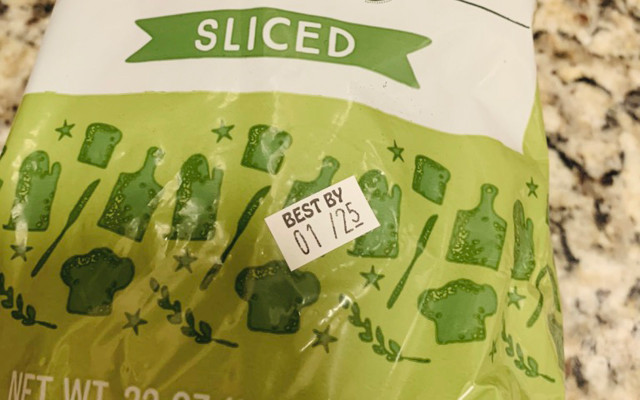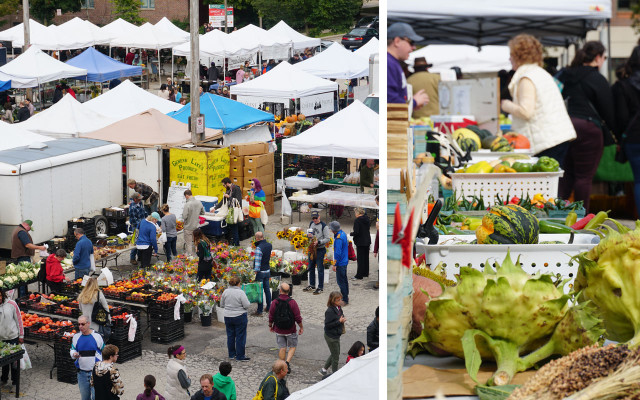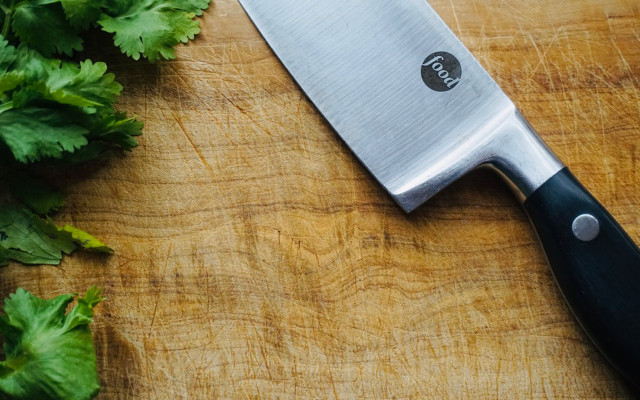-
Photo: CC0 Public Domain / Unsplash - Toa Heftiba (L); Elaine Casap (R)
-
Photo: CC0 Public Domain / Unsplash - FOODISM360
-
Photo: © Utopia / Binford
-
Photo: © Utopia / Evan Binford
-
Photo: © Utopia / Evan Binford
-
Photo: © To Good To Go
-
Photo: © Utopia / Evan Binford
-
Photo: © Utopia / Binford (L); CC0 Public Domain / Unsplash - Joseph Gonzalez
-
Photo: CC0 Public Domain / Unsplash - Toa Heftiba
-
Photo: © Utopia / Binford
-
Photo: CC0 Public Domain / Unsplash - Joyce Romero
-
Photo: CC0 Public Domain / Unsplash - Elaine Casap
-
Photo: CC0 Public Domain / Unsplash - Alexandr Podvalny
-
Photo: CC0 Public Domain / Unsplash - Leonie Wise
-
Photo: © Utopia / Binford
-
Reduce Food Waste like a Pro: 10 Tips
Food waste is a serious problem. Only about two-thirds of all the food we produce gets eaten. At the same time, there are people starving all around the globe. There’s something wrong here.
It’s a fact – we’re all collectively responsible for food waste. And it’s up to us to do something about it as responsible consumers.
-
Food Waste: The Stats
The USDA estimates that around 133 billion pounds of food was wasted in 2010. This equates to around 30-40% of our entire food supply.
The proportion of food wasted at retail and consumer levels tops out at a shocking 31%. Supermarkets store their goods improperly, consumers overbuy and overcook and send the leftovers to the trash. The average American family of four wastes 1,160 lbs. of food each year.
Food waste is a problem we all need to address. Here are 10 everyday tips on how to reduce food waste in your own home.
-
Tip #1: Reduce Food Waste: Best-by Dates Are Not Safety Dates
Foods often head straight for the trash after reaching their best-by date. These “expired” foods are often still edible – and taste not a day older. Food dating labels such “Best if used by/before” and “Sell-by” are not safety dates, rather they refer to guaranteed food quality.
More often than not, you can eat foods days or even weeks past their best-by dates. Our tip: Take a close look at the product in question, touch it, smell it, and trust your wits! Odds are it doesn’t need to head for the garbage just yet.
-
Tip #2: Buy Seasonal and Local Produce
Take a stand against climate change and buy your fruits and vegetables in-season from local or regional producers. Seasonal produce stays fresh longer and isn’t shipped across the globe. Local food has a lower risk of being damaged and thrown out.
Reduce food waste by visiting your local farmers’ market or local produce section of your grocery store on your next shopping trip.
Looking for more sustainable everyday tips? Check out: Take Action: 15 Everyday Ways to Combat Climate Change
-
Tip #3: Buy Ugly Produce
Massive amounts of food is thrown out well before ever making it to the supermarkets. Why? Consumers want perfection. We want to see perfectly straight carrots and round apples. But when it comes to food, it’s what’s on the inside that counts.
Take a stand against food waste by snatching up the ugliest carrots and bell peppers you can on your next outing. Reduce food waste by giving these guys a chance.
Interested in sustainable shopping? Here are some more green and easy tips: Plastic-Free Shopping: 3 Easy Tips for Waste Reduction.
-
Tip #4: Save Food by App
The App Too Good To Go is helping to reduce food waste at the retail level. It works like this: Restaurants, cafés and bakeries take leftover foods – whether it be sandwiches or sushi – and sell them at reduced prices before closing.
Play your role in the fight against food waste and learn more here: Too Good To Go
-
Tip #5: Stop Food Waste: Store Foods Correctly
How you store your food can effect how long your food lasts. For example, potatoes and onions like dark places that aren’t too chilly. Tomatoes and citrus fruits are also rather sensitive to the cold. Fresh produce such as salad and spinach always belongs in the fridge.
Store your food right and reduce food waste in your home:
-
Tip #6: Don't Buy Too Much
Only buy what you actually need. Bulk offers don’t always make this easy. However, we usually know who we’re cooking for.
One helpful way to buy less is to limit your shopping list to what you’ll be eating or cooking that day or this week. This ensures no food goes to waste by hiding in the back of the fridge.
Foods such as lettuce, spinach, berries, mushrooms and broccoli don’t last long in the fridge. Buy with a plan, cook and eat in a timely manner and you’ll reduce waste like a pro.
Utopia’s tip: Healthy Meal Prep Ideas: Easy Meal Planning Tips
-
Tip #7: Be a Clean-Plate Ranger!
The “only as needed” approach to your shopping list also applies to cooking: Make enough, but only enough. Clear your plate and you avoid sending uneaten food to the trash. And if there are leftovers, pack them up for tomorrow in reusable containers or freeze foods for the weeks ahead.
Here are some more tips on reducing food waste in the kitchen:
-
Tip #8: Put Food Scraps Back to Use!
Put a stop to food waste by reducing the amount of kitchen scraps and leftover produce you throw away.
Creatively reuse an entire bounty of lean-kitchen vegetable scraps – take those piles of leftover veggie peels and off-cuts and make yourself a tasty vegetable broth or homemade pesto. You can also fry up washed (organic!) potato skins or roast them in a pan or oven to make chips. Find your own favorite reuse-recipe and stop food waste in its tracks.
Learn more about how to cut down on food waste:
- Reuse Vegetable Scraps: Skip the Trash and put Food back on your Plate
- Banana Peel Uses: Why You Shouldn’t Throw Them Away
- Can You Eat Pumpkin Seeds + Shells? Yes — Here’s How
-
Tip #9: Eat Together, Waste Less
So there was a sale on spinach and you snatched up a little too much to handle? That sack of potatoes on your shelf is growing sprouts? Parmesan in the fridge only has a couple days left?
Put that food to use in no time by sharing with friends, neighbors or coworkers! Invite them over for dinner or cook a delicious meal together. Reduce food waste together and enjoy doing it.
-
Tip #10: Food Sharing: Reduce Food Waste, Help Your Community
So you’ve bought too much food and the leftovers have piled up in your fridge? Short on time but don’t want take-out for the fifth time this week? Join the food sharing community and help to reduce food waste!
Food sharing apps make it easy for retail as well as non-retail participants to share food with those in the community.
Check out these food sharing apps and reduce food waste like a pro:
-
Why We Waste Food
Producers discard items which don’t fit the market profile in appearance, distributors and supermarkets sort out the best and throw away the rest. Grocery stores also take the liberty of tossing items before their expiration date because they know nobody will buy them. Last but not least, we consumers toss anything out that looks like it “isn’t good anymore”, or whatever we think can’t be used.
To add to this, consumers want access to all types of foods all year round. Imports from far away places only add to the problem of food waste. Not all the avocados survive the journey.
-
Some More Tips on How to Reduce Food Waste
Consumers such are the bulk of the problem when it comes to food waste. Why? We’re impulsive. We buy things on a whim. Enacting change begins with thinking things through.
Here are some more tips to help you reduce food waste:
-
Book Your Trip to Utopia Today
Check us out on social media!
Follow us
- … on Facebook
- … on Instagram
- … on Pinterest
Do you like this post?






 Photo: CC0 Public Domain / Unsplash - Toa Heftiba (L); Elaine Casap (R)
Photo: CC0 Public Domain / Unsplash - Toa Heftiba (L); Elaine Casap (R)  Photo: CC0 Public Domain / Unsplash - FOODISM360
Photo: CC0 Public Domain / Unsplash - FOODISM360  Photo: © Utopia / Binford
Photo: © Utopia / Binford  Photo: © Utopia / Evan Binford
Photo: © Utopia / Evan Binford  Photo: © Utopia / Evan Binford
Photo: © Utopia / Evan Binford  Photo: © To Good To Go
Photo: © To Good To Go  Photo: © Utopia / Evan Binford
Photo: © Utopia / Evan Binford  Photo: © Utopia / Binford (L); CC0 Public Domain / Unsplash - Joseph Gonzalez
Photo: © Utopia / Binford (L); CC0 Public Domain / Unsplash - Joseph Gonzalez  Photo: CC0 Public Domain / Unsplash - Toa Heftiba
Photo: CC0 Public Domain / Unsplash - Toa Heftiba  Photo: © Utopia / Binford
Photo: © Utopia / Binford  Photo: CC0 Public Domain / Unsplash - Joyce Romero
Photo: CC0 Public Domain / Unsplash - Joyce Romero  Photo: CC0 Public Domain / Unsplash - Elaine Casap
Photo: CC0 Public Domain / Unsplash - Elaine Casap  Photo: CC0 Public Domain / Unsplash - Alexandr Podvalny
Photo: CC0 Public Domain / Unsplash - Alexandr Podvalny  Photo: CC0 Public Domain / Unsplash - Leonie Wise
Photo: CC0 Public Domain / Unsplash - Leonie Wise  Photo: © Utopia / Binford
Photo: © Utopia / Binford